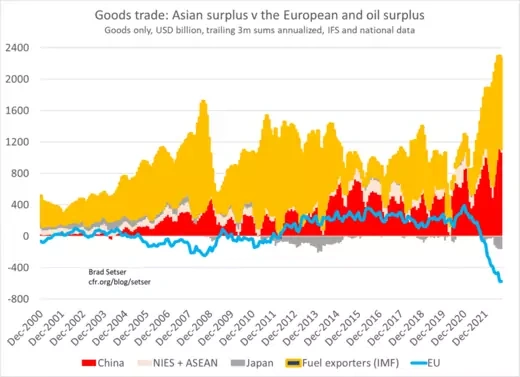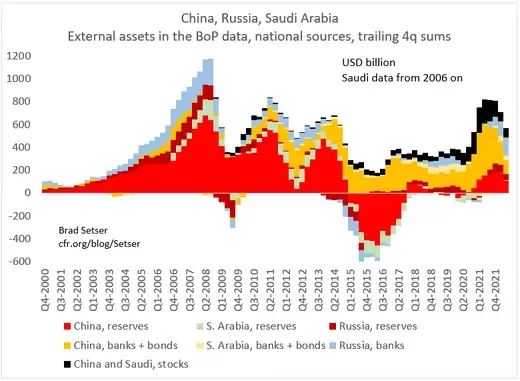I first began to jot down a stability of funds targeted weblog again in 2004.
Initially, I spent most of my time documenting the fast rise in China’s surplus, the relentless rise within the surplus of the oil exporters, and the huge run up in international overseas change reserves—and displaying that for all of the speak (on the time) about change price flexibility, most rising markets have been closely intervening within the overseas change market.
Extra on:
Economics
Rising Economies
China
I additionally sought, with solely restricted success, to determine the vulnerabilities related to that individual international system. The “stability of economic terror” finally held. China by no means stopped financing the US. But by the summer time of 2007, apparent stress had emerged contained in the monetary methods of superior economies.
With hindsight, a world the place demand for secure reserve property far exceeded internet Treasury issuance created monumental issues for monetary intermediation. “Artificial” secure points proved to be a poor substitute for good previous full religion and credit score claims on the U.S. Treasury. It wasn’t the standard knowledge on the time, however a world of huge “uphill” capital flows seemingly may have lasted a bit longer if the US had run bigger fiscal deficits. That will have made the U.S. economic system, and the worldwide economic system, much less depending on European banks to intermediate between the world’s sources of surplus financial savings and the borrowing want of U.S. households.
Resuming this weblog offers a pure level for a little bit of reflection.
However trying again is smart for a second motive: the massive funds imbalances of the worldwide monetary disaster period got here again this yr. And that raises the query of what new dangers—political in addition to financial—are beginning to construct inside the worldwide monetary system.
—
Extra on:
Economics
Rising Economies
China
The U.S. present account deficit is now round 4 p.c of U.S. GDP, and it’s extra more likely to rise towards 5 p.c of GDP over the following couple of years than to observe the IMF’s forecast of an orderly return to three p.c of GDP.
The sturdy greenback impacts commerce with a lag, and it’ll preserve the products and providers deficit up whilst U.S. items demand normalizes. And the brutal dynamics of the U.S. earnings stability is unavoidable. A 2 p.c rise within the common rate of interest the US pays on its exterior debt implies a share level of GDP deterioration within the internet curiosity stability for a rustic that has borrowed (after netting out mounted earnings property) about 50 p.c of its GDP from the world.
However it’s equally necessary to notice that United States isn’t the one G-7 nation operating a big present account deficit both. The UK (UK), after all, nonetheless runs a fairly substantial deficit. Extra importantly, the steep rise in vitality costs together with China’s rising exports to Europe have pushed the euro space right into a stability of funds deficit. Japan’s surplus—which stems from its offshore funding earnings nowadays—has disappeared as effectively.
Massive deficits indicate giant offsetting surpluses.
That reveals up clearly within the uncooked commerce information in chart above. There was an unlimited swing within the commerce surplus of the vitality exporting economies and, surprisingly, China’s surplus additionally has continued to rise.
On account of these shifts, the majority of the world’s exterior surplus is now present in a couple of giant economies that aren’t precisely recognized for his or her dedication to liberal democracy.
Russia’s surplus is about to high $250 billion.
Saudi Arabia’s surplus ought to high $200 billion.
The opposite monarchies within the Gulf ought to have a surplus similar to that of the Saudis—if something, will probably be a bit larger.
And China’s reported present account surplus ought to high $400 billion this yr, and its true surplus may very well be larger.* In some ways, the continuing rise in China’s surplus is essentially the most stunning truth right here, as China is the world’s largest oil importer.
Summed up, these autocratic nations surpluses ought to whole about $1 trillion in 2022. That surplus may dip a bit in 2023 on the again of decrease vitality costs—although any fall in vitality costs will even have a tendency to extend China’s surplus.
To make sure, a couple of “buddies” of the US and the EU have sizable surpluses. Norway is operating a fully large surplus. Switzerland, technically impartial, retains a big surplus fueled by the tax avoidance methods of huge multinationals (Eire is equally operating a big surplus nowadays). Singapore and Taiwan run absurdly giant surpluses in good occasions and nonetheless fairly giant surpluses in dangerous occasions.
However the bulk of the worldwide surplus is now present in nations run by autocratic governments that aren’t buddies of the US. Monetary friend-shoring isn’t an choice.
That’s the deep irony of right this moment’s supposedly deglobalizing world.
Many analysts hypothesize that commerce shall be balkanized as democracies commerce with fellow democracies and autocracies commerce with different autocracies (“friend-shoring”). But, put merely, that sample of commerce is inconsistent with right this moment’s sample of commerce imbalances. The world’s large autocracies can not merely commerce with one another at a time after they collectively are operating a file commerce surplus. Including up constraints are brutal.
The truth is, the worldwide sample of surpluses and deficits right this moment has some parallels with the sample in 2007, the time of “peak” globalization. Each intervals have been marked by giant, concurrent surpluses in rising Asia—notably China—and the oil exporters, and deficits within the US, the UK and (a lot of) Europe.**
However there is a vital distinction between at times: the large autocratic surplus nations usually are not including to their formal overseas change reserves.
Russia after all can not add to its reserves. The Central Financial institution of Russia is financially frozen. Russia surplus is piling up in European banks—aside from the bit that has made its option to Turkey (or Dubai).
Saudi Arabia has chosen to not add to its reserves. Mohammed Bin Salman has a style for threat and needs to scale up Saudi Arabia’s sovereign wealth funds. The Saudi Arabian Financial Company’s conventional portfolio is a bit boring.
And China, it appears, simply isn’t including (a lot) to its reserves. The information stream out of China is wildly complicated proper now. The stability of funds information nonetheless reveals a little bit of reserve development (surprisingly), however the small enhance within the stability of funds information would not map to the secure overseas change reserve place proven on the PBOC’s stability sheet. The state banks appear to have shed a portion of their (substantial) overseas property within the third quarter, at the least in a single information set. Nothing fairly provides up, however there isn’t any doubt that the tempo of China’s reserve development now lags China’s reported present account surplus. The withdrawal of overseas buyers from the Chinese language bond market has absorbed a portion of China’s commerce surplus—and, it appears, China’s exporters even have been build up their offshore financial institution accounts.
The small print listed here are necessary, however for an additional time. The broad level is straightforward: the majority of China’s commerce and present account surplus isn’t displaying up in China’s formal reserves.
It makes for a wierd world.
The massive surpluses are again the place they have been earlier than the worldwide monetary disaster.
However every little thing else is totally different.
The greenback is powerful relatively than weak.
China’s surplus stems as a lot from weak inside demand as from pure export energy.
The oil surplus comes extra from lagging provide (and the prospect of a fall in Russian exports) than from booming demand.
Reserves globally are falling not rising. With the greenback’s present energy, many Asian economies (China excepted) have disgorged a portion of the massive stockpiles.
Treasury issuance far exceeds central financial institution reserve demand.
By implication, personal monetary intermediaries someplace all over the world might want to soak up Treasury bonds. Simply as monetary intermediaries globally needed to soak up U.S. “subprime” (family) threat previous to the worldwide disaster, now they’ve to soak up U.S. rate of interest threat.***
It’s the solely method every little thing provides up.
And the truth of a world the place the large surpluses are in nations that don’t actually wish to be holding all that many {dollars} brazenly has opened up new alternatives for smaller financially troubled states to hunt rescue financing from much less conventional sources. Russia (by its state banks) has helped fund Turkey’s exterior deficit; the Saudis and the opposite Gulf monarchies are offering much more (internet) financing to Egypt than the IMF; and Pakistan and the IMF are relying on China and Saudi Arabia to not pull funds out of the State Financial institution of Pakistan.
The geopolitics of worldwide finance, so to talk, has gotten fascinating.
And international flows, to be sincere, have change into a lot more durable to trace. I nonetheless intend to strive.
*China’s customs (items) surplus has elevated by excess of its broader present account surplus. And the immediately measured customs information may very well be a bit extra correct than China’s extra massaged stability of funds information.
**Japan is in a worse place now than again in 2007, when deficit was held down by its then energetic nuclear crops and its coal use, which was cheaper again then. Oil imports and vitality imports aren’t fairly the identical.
*** Technically, the U.S. monetary system may soak up the entire Treasuries the U.S. must subject and the U.S. exterior deficit may very well be financed by promoting different monetary property to the world (fairness, company bonds, shares in cash market funds, and many others.). Proper now the U.S. worldwide capital flows information (the TIC information) nonetheless reveals important internet inflows into the Treasury market from the remainder of the world. Nevertheless, the majority of the stream is coming from monetary facilities, just like the UK. After all, the UK runs its personal present account deficit; it registers within the U.S. information as a result of giant monetary establishments in London act as international intermediaries.

